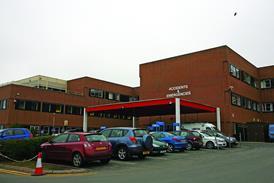New diagnostic technologies can help improve patient outcomes, support changes to our habits and improve surveillance systems to tackle antibiotic resistance, writes Anna Williams
The rising use for antibiotics was linked with the growing prevalence of antimicrobial resistance in a Public Health England report, published last month.

To most health professionals this is not groundbreaking news. Nevertheless, our understanding of the development mechanisms of resistance pales in comparison to the magnitude of the problem it presents.
Thankfully, this year there has been much very vocal activity about antimicrobial resistance, such as the publicity surrounding the Longitude Prize.
‘Projects such as the Longitude Prize should make us all re-examine our own relationship with antibiotics’
Projects such as these should make us all re-examine our own relationship with antibiotics and look at what can be done to help slow resistance. There is no “magic bullet” for this problem but more can be done to help both from a technical and a social perspective.
Today marks the launch of the Longitude Prize, so it is fitting that we should open the competition for entries on the same occasion as European countries come together for Antibiotics Awareness Day.
There is no better time to spread the message about prudent use of antibiotics and reflect on the global problem of antibiotic resistance.
- GPs feel pressured over antibiotics
- Supporting patients will influence antibiotics overuse as much as medical advances
Focus on the future
The Longitude Prize 2014 is a competition with a £10m fund to tackle antibiotic resistance.
I work as a researcher in the team developing the prize at Nesta. We are asking people from across the globe to come up with a point of care diagnostic to detect and understand infections to enable the prescription of the right antibiotics at the right time.
We hope entrants produce new and innovative diagnostics that will ultimately help to slow the rate of antimicrobial resistance and enable us to safeguard antibiotics for the future.
‘There’s a challenge in developing a diagnostic that is rapid and sufficiently accurate as well as cost effective’
Tools and tests are one way to help us slow resistance by providing healthcare professionals with information to help make accurate clinical decisions. They can help definitively rule in or out bacterial infection, directly informing the decision to prescribe antibiotics.
However, there remains a technical challenge in developing a diagnostic that is rapid and sufficiently accurate to inform antibiotic prescriptions at the point of care, as well as being cost effective.
The diagnostics the Longitude Prize seeks to develop may also go one step further by providing all of the necessary information to identify an effective antibiotic or combination of antibiotics.
This would allow clinicians to use a targeted, narrow spectrum of antibiotics that perhaps they wouldn’t normally use on the first occasion, thereby minimising the use of broad spectrum antibiotics.
There are some exciting diagnostics out there already – for example, Spectromics is in the patent application stage for its urinary tract infection diagnostic.
The test monitors phenotypic change that occurs between a urine sample and different candidate antibiotics to provide guidance on the most effective treatment.
Up to 70 per cent of urinary tract infections are resistant, so Spectromics and other innovators in the field have the potential to inform accurate diagnosis and treatment, thereby improving care for a large proportion of patients.
Swelling numbers
Inflammation can be an indicator for bacterial infection and there are several tests that have been developed to detect biomarkers for inflammation. There are a variety of blood based tests for procalcitonin levels that are able to detect sepsis in patients.
A recent systematic review of these tests showed that they may be effective in informing the initiation and termination of antibiotic treatment for respiratory infection, reducing overall exposure to antibiotics. This is encouraging news.
‘The prize is pushing innovators to address inadequacies and be ambitious’
However, the relative benefits of inflammatory tests such as procalcitonin and C-reactive protein are widely debated, so there is a need for further research into their use in primary care settings.
There has been innovation in the range of tests for bacterial infection, but they generally are unable to fully demonstrate cost effectiveness, accuracy and usability in comparison with the best available alternatives.
The Longitude Prize is pushing innovators to address such inadequacies and calling for a more ambitious test than anything currently available.
Surveillance tactics
Better surveillance techniques to collate data on bacterial resistance will help us better understand its spread and underlying mechanisms. The more we understand the situation facing us, the better we can deal with the issue head on.
Surveillance is needed in all environments where resistance can occur and diagnostics can act as a tool for collecting information.
At a national level, hospitals are best equipped to carry out surveillance. However, more and more care is being delivered in the community by multiple organisations providing more than one services and this may lead to difficulty in implementing standards for surveillance.
‘Surveillance is needed in all environments where resistance can occur and diagnostics can help collect information’
Explicit infection control policies need to be developed by each organisation responsible for the care of individuals, which are specific to the settings of care. This should include all care settings, from hospitals to homes, community transport and day centres.
The standardised collection of data through diagnostic devices presents a simple way to increase surveillance in these settings.
The 2011 chief medical officer’s annual report asserts that NHS England is well placed to collect, collate, analyse and disseminate information from surveillance. The UK needs to develop methods to ensure consistency and standardisation of data collection, but we also need to understand how this data will be used, so we collect the most useful information.
The European Centre for Disease Prevention and Control sets a good model for best practice in data collection, evaluation and dissemination. Such models should be considered when action is taken to federate and connect databases from health and social care in the UK.
The chief medical officer has also called for interoperability standards for health information systems, so emerging surveillance technologies can easily be integrated. This interoperability will also provide vital flexibility when actions are taken to globally integrate surveillance efforts.
Human nature
Human behaviour plays a big role in tackling resistance. The British public demonstrated their support for tackling the issue of antibiotic resistance by voting that this should be the focus of the Longitude Prize.
In a new survey - published today for the prize - 78 per cent of respondents expressed concern about the issue of antibiotic resistance. However, it is interesting that public concern may not always translate into responsible behaviour, because nearly a quarter of respondents admitted to not completing a course of antibiotics prescribed to them.
Our own actions can contribute to resistance. Whether a doctor has prescribed antibiotics when not necessary or whether a patient has decided not to finish a course, all rests with the individual’s responsibility.
‘The public’s and doctors’ own actions contribute to antibiotic resistance’
Every time we expose bacteria unnecessarily to antibiotics, we create an environment that is favourable to the development of resistance. In another survey for the Longitude Prize, 28 per cent of British GPs prescribe antibiotics “several times a week”, even when they’re not sure they’re medically necessary.
Nearly all (90 per cent) say they feel pressure from patients to prescribe: 70 per cent do so because they’re not sure whether the patient has a viral or bacterial infection, and 24 per cent say it’s because they lack easy to use diagnostic tools.
New diagnostic technologies can help improve patient outcomes, support changes to our habits and improve surveillance systems to tackle antibiotic resistance.
As well as technology to combat resistance there must be local, national and global action to innovate within healthcare systems to make effective use of existing tools and resources to tackle the problem.
We hope diagnostics will play a key role in making this journey easier.
Anna Williams is a research at Nesta


























No comments yet